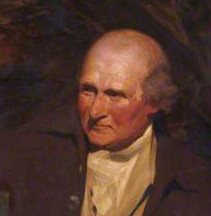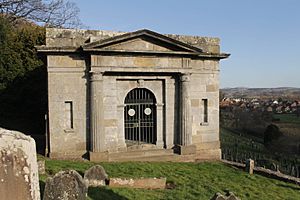John Johnstone (East India Company) facts for kids
Quick facts for kids
John Johnstone
|
|
|---|---|

from a larger painting
|
|
| Born | 28 April 1734 |
| Died | 10 December 1795 (aged 61) Alva, Clackmannanshire, Scotland
|
| Nationality | Scottish |
| Known for | Making a fortune in India (equivalent to £21 million in 2026). |
| Spouse(s) | Elizabeth |
John Johnstone (born April 28, 1734 – died December 10, 1795) was a Scottish man who made a huge fortune while working for the British East India Company in India. He was known for returning to Scotland with great wealth. People described him as a very smart and determined businessman. He managed to get through several difficult situations and became a major landowner when he came back to Scotland in 1765.
Johnstone was also a member of the House of Commons of Great Britain, which is like a parliament, from 1774 to 1780. He won his election in the Dysart Burghs by using his influence and money.
Contents
Early Life and Family Connections
Johnstone was born in Edinburgh, Scotland. He was the fifth son of Sir James Johnstone, 3rd Baronet and his wife, Barbara. His family was quite important.
He had several brothers who also became well-known. One brother, Sir James Johnstone, 4th Baronet, was an army officer and politician. Another brother, William, became a wealthy lawyer and politician. His brother George Johnstone was a naval officer and politician. Sadly, another brother named Patrick died in a famous event called the Black Hole of Calcutta.
In 1765, John Johnstone married Elizabeth Caroline Keene. They had one son and one daughter. His daughter, Ann Elizabeth, married James Gordon. His son, James Raymond Johnstone, married Mary Elizabeth Cholmeley.
The Johnstone family became very powerful. People even said that by the late 1750s, they were involved in almost every big event happening in the British Empire.
Career in India
Starting Out in Bengal
Johnstone first went to Bengal, India, in 1751. He worked for the East India Company as a "writer," which was like an administrator or clerk. In 1756, he was in Dacca when a conflict started, and he was taken prisoner.
After he was released, and after his brother Patrick died, he decided to join the company's army. He fought alongside Robert Clive in the Battle of Plassey. After more military service, he went back to his civilian job in 1757.
Rising Through the Ranks
Around 1760, Johnstone was put in charge of the company's business in Midnapore. He also became a member of the Bengal Council, which was an important group that helped run things. He did very well there, so in 1762, he was moved to Burdwan.
In Burdwan, he started his own private businesses. This led to disagreements with Henry Vansittart, who was the Governor of Bengal. Because of these conflicts, the Company fired Johnstone in early 1764. However, the Company's main leaders in Britain, called the Court of Directors, changed this decision. They brought him back to his job in May 1764.
Making a Fortune and Returning Home
Johnstone's former friend, Robert Clive, did not want him back in his old job. When Clive became the new governor in 1765, he started looking into large gifts Johnstone had received. These gifts, totaling over £50,000, came from the new ruler of Bengal, Najimuddin Ali Khan.
The Company had made new rules in 1764. These rules said that their officers could only accept big gifts if the directors approved it first. Clive forced Johnstone to resign. In October 1765, Johnstone sailed back to Britain. He brought with him a huge fortune, estimated to be about £300,000. This amount would be worth many millions of pounds today!
At just 31 years old, Johnstone used his money to buy large estates in Scotland. He first bought land at Alva and later in Selkirkshire and Dumfriesshire.
Life in Scotland

The Johnstone family records say that he spent about a ninth of his money on the estates at Alva, Hanginghaw, and Denovan. They also said he "lived quietly" there until he was elected to Parliament.
However, letters he wrote to his brother William show that he continued to be involved in business deals and trying to influence the stock market.
Meanwhile, the leaders of the East India Company tried to take legal action against Johnstone for his actions in India. His friends, especially George Dempster, spoke up for him. In his defense, Johnstone published a letter in 1766. It was called "A letter to the proprietors of East-India stock" and explained why he accepted gifts from Indian rulers.
In May 1767, the main meeting of the East India Company decided to drop all legal cases against its former employees. So, Johnstone was free from any charges.
Entering Politics
The next year, in the 1768 election, Johnstone tried to win a seat in Parliament for Haslemere. But he was not successful.
At the next election in 1774, Johnstone used his cleverness and money to win the seat for Dysart Burghs. This area included five towns in Fife: Kirkcaldy, Burntisland, Kinghorn, and Dysart. A newspaper reported that Johnstone waited until the towns had chosen their representatives before he announced he wanted to run. This surprised the current Member of Parliament, James Oswald. Johnstone won the support of Dysart and used his influence to get the backing of the representatives from Burntisland and Kinghorn. This helped him win the seat.
However, in the 1780 election, Johnstone lost the support of Burntisland. His opponent, John Henderson, won the seat.
Death and Legacy
John Johnstone passed away on December 10, 1795, at his home, Alva House. He was 61 years old. Alva House had been redesigned and made bigger in 1789 by a famous architect named Robert Adam.
Robert Adam also designed a special family mausoleum (a building to hold graves) for Johnstone and his wife Caroline in the Alva churchyard.
His son, James Raymond Johnstone (who died in 1830), had eight children. The oldest of these, James Johnstone (1801–1888), also became a Member of Parliament for Clackmannanshire and Kinross-shire.
Alva House stayed in his family for over a hundred years. In 1890, it went to his descendant, Carolin Johnstone. She sold some of the land around the house to pay off her debts, but she couldn't clear them all. By the 1920s, the house was empty and abandoned. During World War II, it was even used for target practice, and it was left in ruins.



